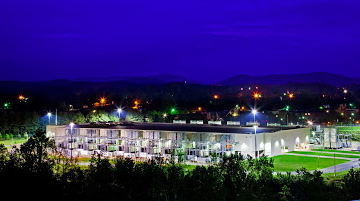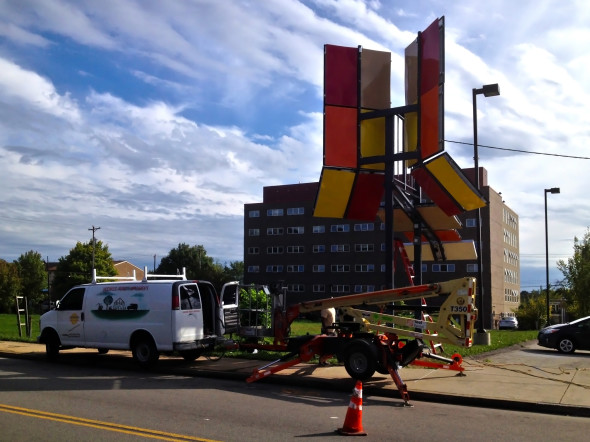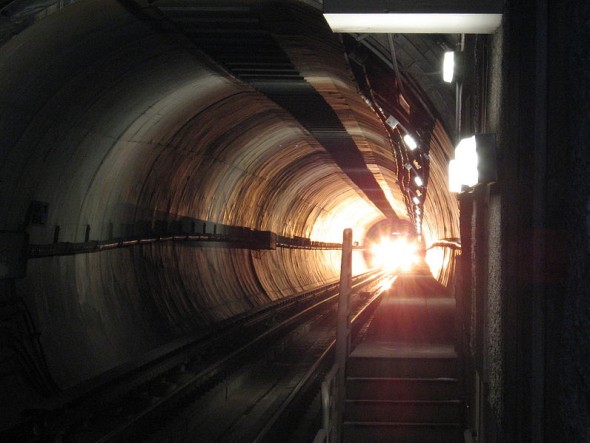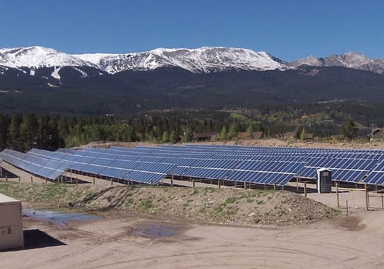GreenBiz | April 24, 2013 | Original headline: How Google is changing the renewables game for Apple, Facebook
 The need to consume ever-increasing amounts of energy in their data centers — yet continue marching towards renewable energy goals — has been an ongoing challenge for Google and Apple.
The need to consume ever-increasing amounts of energy in their data centers — yet continue marching towards renewable energy goals — has been an ongoing challenge for Google and Apple.
Google has offset electricity needed for its centers through purchase power agreements that enable an equal amount of renewable energy to be created, yet has lamented that managing power sales and purchases on the wholesale market takes time away from its focus on building user products.
And despite Apple’s onsite generation of renewable energy, it has still had to supplement its need for renewables through buying off the grid and purchasing renewable energy certificates to offset the conventional portion, green IT experts say.
It’s a conundrum that has kept the Silicon Valley tech giants within the constraints of local utilities’ energy mix in states that don’t permit direct purchases of renewable energy.
Nowhere has this challenge been more evident than in North Carolina, an indirect access state that houses data centers for Google, Apple and Facebook as well as AT&T, Wipro and Disney. Compounding matters further is proposed legislation that would repeal the state’s renewable portfolio standard mandating that 12.5 percent of North Carolina’s energy mix come from renewable sources by 2021.
But things are looking up. Now, Google is trying to transform the local landscape in North Carolina by partnering with Duke Energy. The pair worked together to develop a mechanism which will enable companies of all sizes to directly purchase renewables through a new category dubbed “renewable energy tariffs.”
“The tariffs are creating a new class of service,” said Michael Terrell, who leads Google’s public policy efforts in energy and sustainability. “We think it will be a good framework for purchasing renewable energy,” he told GreenBiz.
Before the program can be launched, though, the new class and tariff structure needs to be approved by the North Carolina Utiltiies Commission. Duke Energy will make a regulatory filing asking for its adoption within the next three months.
Under the tariff, renewable energy will be sold at specific rates yet to be determined — higher than conventional sources, of course, but passed on only to those who choose to participate in the program.
“What we think is exciting is that it’s scaleable – it allows companies to buy large amounts of renewables … not every company can manage power on the wholesale market,” Terrell said.
Terrell said that he hopes the tariff will be in place by the end of the year.
Google’s announcement of the renewable energy tariff concept last Friday came on the same day it released plans to expand its Lenoir, N.C. data center with $600 million in investments. The possibility of accessing more renewable energy directly will come in handy for the company striving to reach a commitment it made in 2007 to become carbon neutral.
Implications for Apple, Facebook
Apple
The renewable energy tariff promises to boost Apple’s tally of renewable energy directly purchased for use at its data center in Maiden, N.C.
Despite Apple’s claim last month that its data centers are powered by 100 percent renewable energy, experts say that based on the information the company has released, it does buy conventional power off the grid in North Carolina (comprised mainly of coal and nuclear power in 2013, according to a Duke Energy report filed to the state’s utilities commission) to supplement what it cannot supply on its own from its 20 MW solar array and 10 MW fuel cell installation at the Maiden data center.
According to Brad Brech, a data center energy efficiency expert and board member of the Portland-based Green Grid, Apple fell short of its claim.
“Assuming that the facility runs the fuel cells at their rated capacity, they will be running their data center at its average operational load in 2012 on 85 percent renewable energy. On a sunny day, the facility will be running on 100 percent renewable energy for eight to 10 hours because the 20 MW solar farm is feeding the grid during that time period, increasing the percentage of the time the data center runs on renewable energy to 91.3 percent of the day,” Brech told GreenBiz. “On a rainy day, it will be 85 percent.”
Brech used Apple’s reported figure of the Maiden data center’s total consumption of 104,000 MWh in 2012 as a basis for his calculations, which he said on average requires 11.8 MW of generation capacity.
“With the current renewable energy generation and energy storage technologies, it is extremely difficult to run a facility that uses large amounts of electricity on renewable energy 24 hours per day, seven days per week,” Brech added. “Most renewable energy generation sources for electricity are intermittent and then are no economical, large scale energy storage technologies available to store electricity for release when the renewable sources are not generating.”
Gary Cook, an IT analyst for Greenpeace, also weighed in. “Apple is otherwise buying renewable energy credits to allow it to claim that all of the electricity it buys is renewable energy,” he told GreenBiz. “It’s not clear how much of Apple’s 100 percent renewable energy claim is being supported by REC purchases. … Technically speaking, if Apple used the current standard for reporting greenhouse gas emissions, Apple would have to use Duke’s grid mix.”
“Given that they expect the Maiden facility to grow and its electricity use increase it will be difficult to achieve 100 percent renewable energy use and assure the reliable operation of the facility,” Brech concluded. “The reality is that all users of renewable energy, whether they are residential or commercial, depend on grid-generated electricity for some part of the day.”
Apple did not make a spokesperson available to respond.
Facebook
The social media company runs a data center in Forest City, N.C., operates another in Prineville, Ore., is building a third in Lulea, Sweden and recently announced plans for a fourth near Des Moines, Iowa. While it has not been as aggressive as Google or Apple in the renewables market so far, it has a goal to reach 25 percent use of renewable energy at its data centers and facilities by 2015. And it’s planning to tap into renewable energy sources for its data centers in Sweden and Iowa, according to Reuters.
If Duke Energy’s regulatory filing to the North Carolina Utilities Commission to establish renewable energy tariffs is approved, Facebook will also have the opportunity to increase its use of renewables in Forest City.
Duke Energy spokesperson Jeff Brooks told GreenBiz that he didn’t know whether Facebook or Apple has expressed interest in participating in the renewable energy tariff program.
GigaOM‘s Katie Fehrenbacher reported last summer that Facebook’s head of energy efficiency and sustainability Bill Weihl expressed interest in purchasing renewable energy through an industry trade association which would “influence utilities’ grid choices through the group purchasing of clean power,” the article read.
How the renewable tariff program would work
Google and Duke Energy still have yet to hammer out much of the details of the renewable tariff program, which is a separate initiative from the state’s renewable portfolio standard.
The program will initially focus on large commercial and industrial companies as customers, according to Google.
“They have fairly predictable energy loads and it’s consistent, which makes it easy to design a rate that will meet their needs,” said Brooks, who added that Duke Energy had been discussing the tariff program with Google in detail for the last several months. General discussion about the idea began when Google first asked Duke Energy for a renewables rate during initial discussions about expanding its Lenoir data center, according to Brooks.
To start, the customer will decide if they want to offset some or all of its energy consumption, then the utility will match the customer with a project in the region that has a third party purchase agreement, Brooks said.
In addition to the utility going out and identifying renewable project sources, projects can approach the utility and come in under the tariff, he continued.
While Brooks could not project the level of demand in North Carolina for directly purchased renewables, he said he sees a potential for long-term growth of renewable energy sources.
“We’ve seen renewable energy projects bloom in the state over the last few years, and we’ve seen a great interest in solar energy companies, wind and even biomass and other forms of methane gas projects too. Solar in particular has really boomed in the past few years, and we’ve seen costs come down for those technologies,” Brooks said.
Terrell said that Google has been speaking to other utilities about the renewable energy tariff proposal. According to Brooks, the idea to offer renewable energy rates to various customer classes is fairly new but not entirely unique. Dominion Virginia Power, he said, provides a similar offering.
“It’s [an idea] that utilities are exploring in different ways,” he said.
View the original story.




